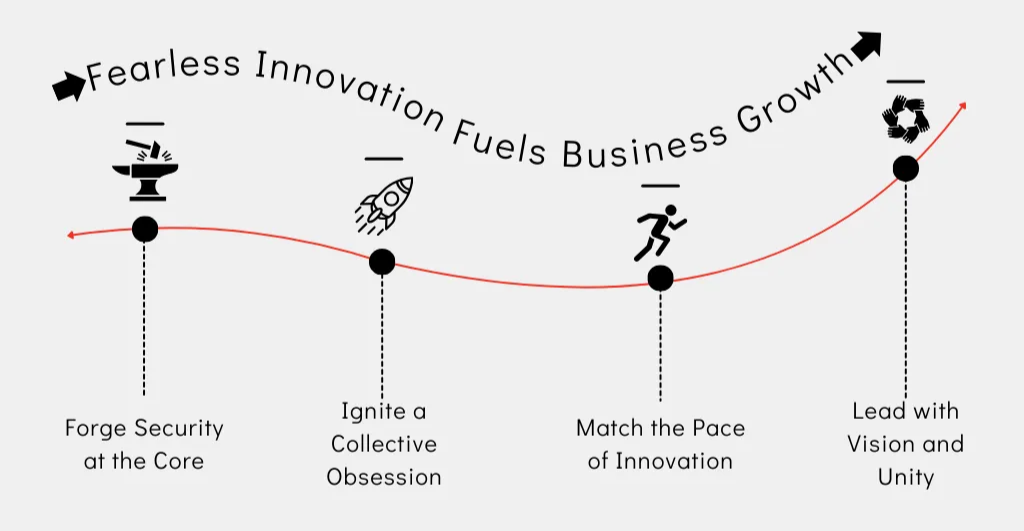
Breakthroughs & Barricades: The Innovation Imperative & the Security Mandate
Jacob Combs
March 14, 2025
The ground beneath our feet is shifting faster than ever, transforming the way we build and innovate. What once took months can now be prototyped in days. The past six months alone have demolished barriers that once seemed insurmountable—AI has made the hard stuff easy.
Yet, paradoxically, as AI makes the hard stuff easy, the bar for genuine innovation has never been higher. What once set companies apart is now commonplace.
Meanwhile, adequate security isn’t getting any easier. Your competitors have AI, but guess what? So do attackers. And while AI accelerates development, it doesn’t eliminate risk. It certainly can’t outthink a determined human adversary armed with the same tools.
The companies that will thrive aren’t choosing between speed and security—they're mastering both simultaneously. Security, when done right, doesn’t just protect your product—it becomes a catalyst for sustainable innovation.
Where Speed and Security Collide
Mastering both speed and security isn't just a competitive advantage—it's a survival requirement. That brings us to an unavoidable truth: where speed and security collide, tensions emerge.
To strike the right balance, we first need to confront the real challenges at play—challenges that can’t be ignored:
- The Pressure of Time-to-Market is relentless. When executives are pushing for quick releases and your competitors are shipping weekly, security reviews that add days to the cycle feel like anchors.
- The Evolving Threat Landscape grows more sophisticated daily. Attackers don't care about your release schedule—they're probing continuously, leveraging the same AI tools you use to build.
- The Cost of Technical and Security Debt compounds silently until it doesn't. I've seen organizations brought to their knees not by the sophisticated zero-day, but by the vulnerability they "temporarily" accepted six months ago.
- Legacy Security Practices still plague us. Annual pen tests and waterfall security reviews are fundamentally incompatible with CI/CD pipelines pushing code hourly.
For too long, security has been cast as an obstacle to innovation, rather than an enabler. I’ve seen firsthand how this mindset hinders progress. If you’ve ever been told, “You’re killing the culture of the company!”—you’re not alone.
It’s time to put this false dichotomy to rest. The reality is far more compelling—security and innovation don’t merely coexist; they amplify one another. Here’s my take on navigating this balance in today’s rapidly evolving product landscape.
Fearless Innovation: A Security Framework That Fuels Progress
Over two decades in the trenches—spanning startups to Fortune 500 giants—I’ve forged an approach that delivers. This isn’t theory; it’s battle-tested across industries and scales.

1. Forge Security at the Core
Tacking security onto a product after the fact is a recipe for friction—slowing progress and frustrating teams. The smarter play? Weave it into the foundation, right where the big ideas take shape. This isn’t about slowing down innovation; it’s about arming it to thrive.
- Threat Modeling as a Team Sport: On a recent project, we pulled a security architect into our earliest design sprints. Mid-session, they spotted an authorization gap that could’ve spiraled into a multi-week rewrite later. The devs didn’t roll their eyes—they high-fived. Early wins build trust.
- User Stories That Pack a Punch: We’ve upgraded our approach by embedding security into the DNA of our requirements—like adding “API calls must validate auth tokens” as a non-negotiable acceptance criterion. It’s a subtle shift that pays outsized dividends.
- Real-Time Guardrails: We’ve wired automated tools—think SAST and DAST—into our commit pipelines. High-severity flaws get flagged instantly, complete with fix suggestions. No more delayed security tickets; developers get feedback when it matters most.
The payoff? Vulnerabilities get crushed when they’re cheapest to fix, significantly reducing remediation costs and potential financial losses. This approach accelerates time to market by eliminating costly late-stage security rework, decreases risk exposure, and strengthens customer trust, ultimately contributing to a more resilient and competitive business.
2. Ignite a Collective Obsession
Your best defense isn’t a tool or a policy—it’s a team that lives and breathes security. Firewalls can fail, but a culture that owns it never will.
- Hands-On Awakening: Replace traditional compliance training with interactive workshops. I have seen companies implement monthly “Hack Your Own App” challenges, where developers test each other’s code for vulnerabilities. Experiencing the impact of a security flaw firsthand provides a lasting lesson.
- No More Silos: We’ve obliterated the line between “security crew” and “dev squad.” Security engineers pair-program alongside developers, while devs jump into threat reviews. It’s one team, one mission—security as a shared fight.
- Celebrate the Warriors: Our “Security Champion” award isn’t just a pat on the back—it’s a badge of honor, fiercely contested every quarter. Spot a flaw early? Streamline a process? You’re not just noticed—you’re revered.
When security becomes a craft to master, not a chore to endure, the game shifts. Teams don’t just build safer products—they build better ones, period.
3. Match the Pace of Innovation
Forget clunky security that drags teams down—today’s tech can make it a seamless accelerator. The right systems don’t just guard the gates; they turbocharge your entire operation.
- AI That Outsmarts Risk: We’ve deployed machine-learning models that detect code vulnerabilities before they hit production. These aren’t static scanners—they evolve, learning from every review to spot threats humans might miss. It’s like having a security genius on speed dial.
- Pipelines That Pull Double Duty: Our dev environment delivers relentlessly—dependency checks, container scans, and infrastructure-as-code audits run alongside linting and tests.
- Cloud-Native Muscle: We’ve ditched old-school network walls for identity-driven security that sticks to workloads like a shadow—dynamic, programmable, and relentless. It’s protection that moves as fast as your cloud does.
When tech does the heavy lifting, security doesn’t feel like a tax—it’s invisible rocket fuel for fearless innovation.
4. Lead with Vision and Unity
Security divorced from purpose is a roadblock; tethered to it, it’s a powerhouse. Leaders must fuse it to the mission, proving it’s not a hurdle but a driver of success.
- Smart, Scalable Standards: We’ve scrapped one-size-fits-all rules for risk-based tiers—high-stakes data gets fortress-level scrutiny, while low-risk features stay nimble. It’s precision that frees teams to focus where it counts.
- Paved Paths to Victory: Our platform crew rolls out battle-ready components—hardened templates, libraries, and configs—so developers default to secure without breaking stride. The easy road is the safe road.
- Fusion at the Frontline: Security pros don’t lurk in the shadows—they’re embedded in product squads, shaping architecture and design shoulder-to-shoulder with the team. Collaboration isn’t a checkpoint; it’s creation.
When leaders cast security as a catalyst for winning—not a box to check—innovation doesn’t just survive; it soars. This is how you build a legacy of breakthroughs that last.
Security as a Competitive Advantage
This isn’t about selling security—it’s about what it delivers. Breaches make headlines, and customers notice. A strong security posture doesn’t just stop incidents; it builds trust, and trust matters when decisions are on the line. I’ve seen teams lose deals because their defenses were shaky, and others win because they could prove theirs weren’t.
For us in security, this is a shift: it’s not just risk mitigation—it’s a signal of reliability. When security underpins innovation, products aren’t just safer—they’re better positioned in a market that’s watching. That’s not a pitch; it’s a reality we can’t ignore.
The Journey Forward
This balance isn’t a finish line—it’s an ongoing discipline. Threats evolve, tech accelerates, and the best teams don’t treat security and innovation as a tug-of-war. The principle holds: when they work together, they’re stronger—delivering products that stand up over time. Start where you are:
- Bring a security lead into your next design review—early input catches issues before they fester.
- Add one automated check to your pipeline—it’s a small lift that tightens the loop.
- Call out the person who flags a risk—recognition builds habits, not heroics.
These are practical moves, not grand gestures. They weave security into innovation’s rhythm, cutting risk without killing momentum. In today’s world, with AI and beyond, this isn’t a luxury—it’s how we keep our edge.
Forget trade-offs. Security and innovation aren’t rivals—they’re partners, and our job is to make that real.
Ready to Embed Security into Innovation—Without Slowing Down?
If you want expert guidance on building secure, high-velocity products without compromise, Bodhi Security is here to help. Led by a practicing CISO and product security specialist, we deliver hands-on consulting that aligns security with innovation from day one.
Get in touch at [email protected] or connect with us here.
Let’s make fearless innovation secure—and security fearless.